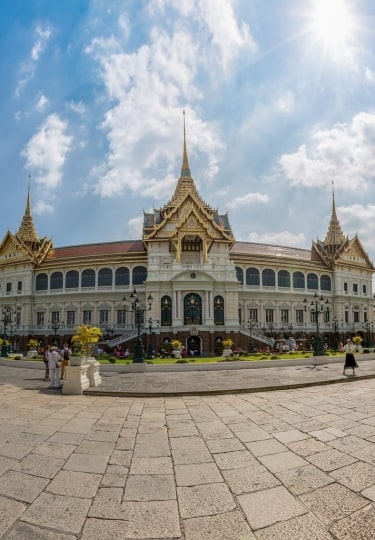The scale of Thailand’s capital city means that even with two days in Bangkok, you’ll only scratch the surface of this surging, eclectic metropolis.
But what a surface to scratch, patinated with the perfume and grain of a city that truly never sleeps. By day and night, Bangkok is a sensory overload, from its streets of swarming tuk-tuks to the solemn, pinnacled spectacle of its elaborate Buddhist temples. With almost two million more inhabitants than London, the “City of Angels” can certainly feel busy—but peel off down a side soi, and it’ll suddenly just be you and a smiling Buddhist monk walking in the other direction.
But you don’t come to Bangkok for the peace and quiet. You come for the sophisticated sky bars, the less sophisticated haggling, and, of course, the transcendent cuisine. Two days in Bangkok can be as straightforward and satisfying as a bowl of tangy pad thai or as complex and lingering as a green curry—whichever you prefer, it’s important to have the very best ingredients. Here are the essential places to see.
Day 1
9:30 a.m.: Pay your respects at the Grand Palace
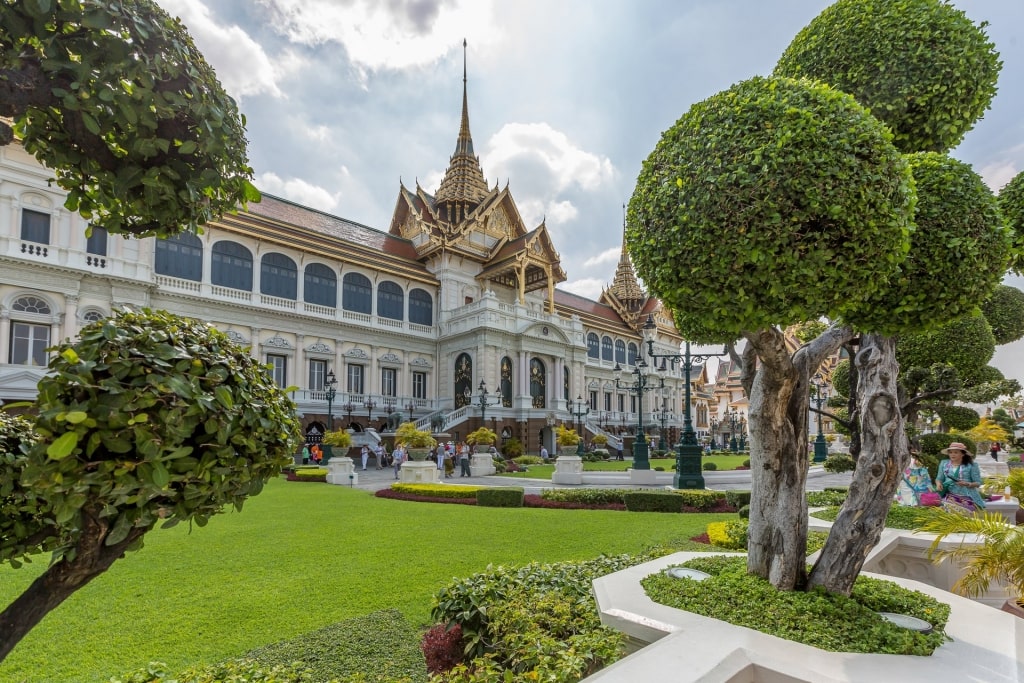
Grand Palace
Seen from the far banks of Bangkok’s wide Chao Praya river, the Grand Palace is one of the best places to visit in Southeast Asia, with its vast complex of ornately tiled buildings crowned by a forest of golden pinnacles.
The Thai royalty’s former official residence is an essential stop for any two-day Bangkok itinerary. Spread across sixty acres, this 18th-century compound showcases some of the country’s most eye-popping architecture. As you wander around its various buildings, you’ll find yourself in what feels like an elaborate sculpture and art museum dedicated to the country’s colorful religious heritage.
There’s also just straight-up pomp and grandeur, as you’ll find exploring the grounds and the four palace buildings open to visitors. Arrive early and you’ll miss the worst of the heat and the tourist crush. While many cultural sites in Thailand might accept minor breaches of dress protocol, be warned that at the Grand Palace, they are strictly observed.
11 a.m.: Cleanse at the Wat Phra Kaew
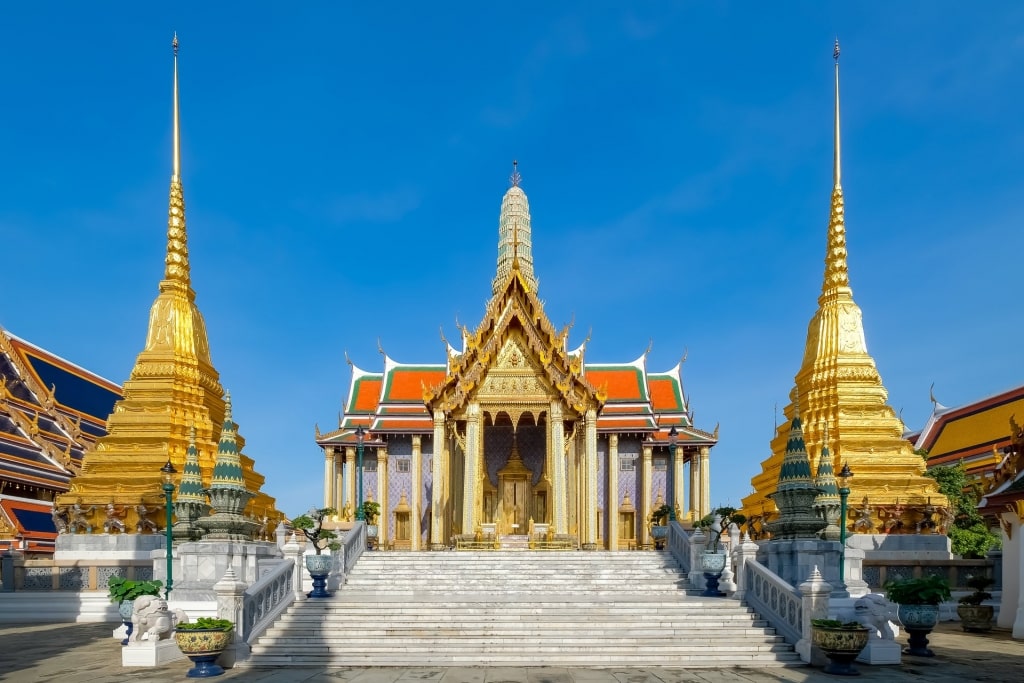
Wat Phra Kaew
Thailand is predominantly a Buddhist country. You’ll see images of the cross-legged buddha everywhere—printed on t-shirts, watching from courtyard alcoves—and in Bangkok, you’re sure to glimpse the saffron robes of Buddhist monks as they slip through the urban throng.
The Wat Phra Kaew, also known as the Temple of The Emerald Buddha, is perhaps the religious site most revered by the Thai populace. Located within the Grand Palace complex, you’ll be surprised by the relatively compact size of the icon referred to as “The Protector of Thailand” once you reach Wat Phra Kaew’s inner sanctum. Sat meditatively on its golden dais, the Emerald Buddha is carved from a single piece of deep green jasper. Its costume is changed seasonally by the King of Thailand.
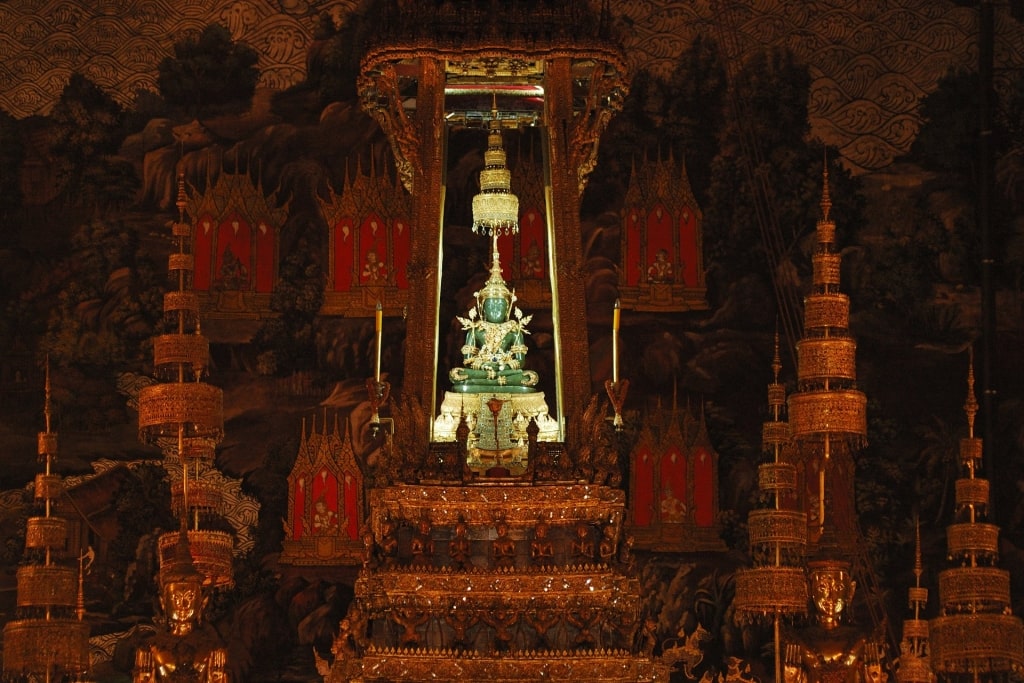
Emerald Buddha, Wat Phra Kaew
The reverence in the room is catching. Equally awe-inspiring is the architecture of the temple which houses it, possibly the first among equals of the elaborate structures found within the Grand Palace.
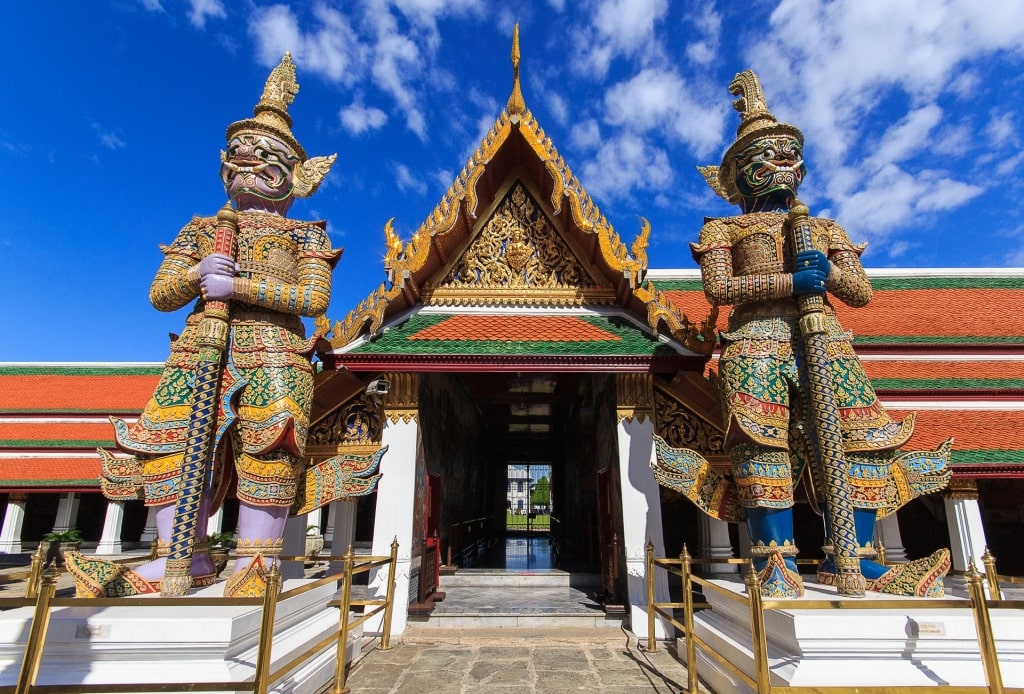
Wat Phra Kaew
Monstrous figures—drawn from Thailand’s national epic, the Ramakien—guard the temple’s entrance. Its balcony is resplendent with intricate murals to pore over that depict the Ramayana. A model of Cambodia’s Angkor Wat is also found within Wat Phra Kaew—a historical holdover from when Thailand occupied much of its neighbor.
If you can fit it into your two days in Bangkok itinerary, make your way out of the Grand Palace to Wat Pho. Another temple of major significance, the 46-meter-long Reclining Buddha offers a giant contrast to the Emerald Buddha.
12 p.m.: Eat Pad Thai
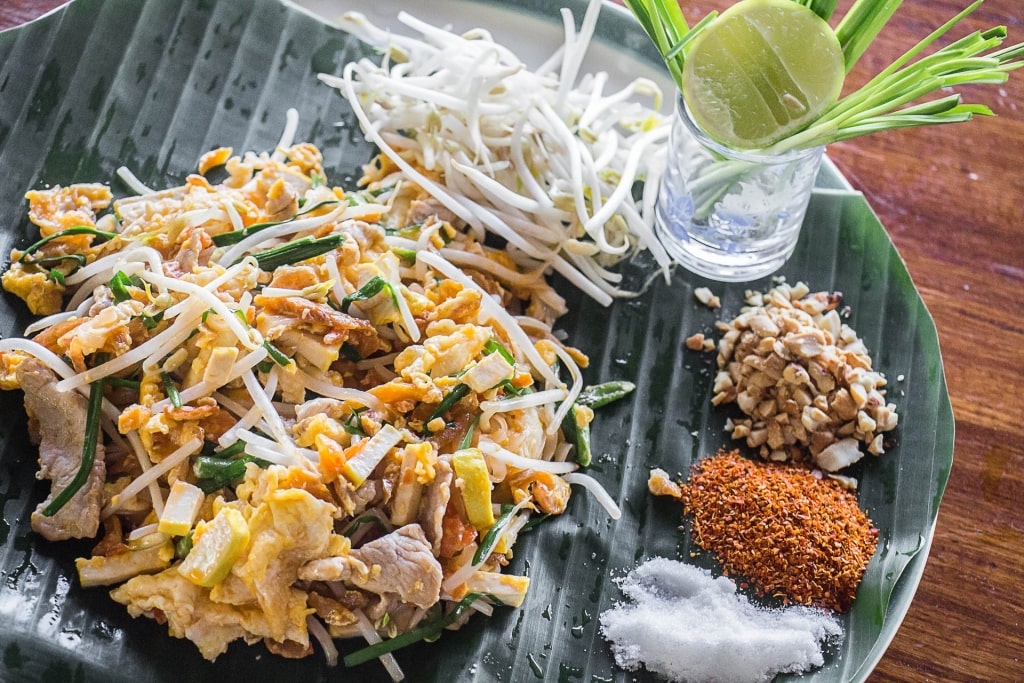
Pad thai
It’s likely that you’ll need little introduction to the marvels of Thai food. Of course, this fragrant and complex cuisine is even more irresistible within its own borders, where its homegrown practitioners can draw upon essential Thai ingredients such as galangal or fingerroot. With food stalls on every street corner, the humid city breezes often carry unexpected fresh notes of lemongrass or plumes of chili heat.
Of all the dishes from the Thai national cookbook, perhaps the most famous is pad thai. This curbside staple has an unexpected political history, its development a piece of delicious propaganda intended to shore up national identity in the 1930s. Its success is thanks to the nature of this stir-fried noodle dish, with its pungent fish sauce and sweet-and-sour tamarind flavors, garnished with chopped peanut.
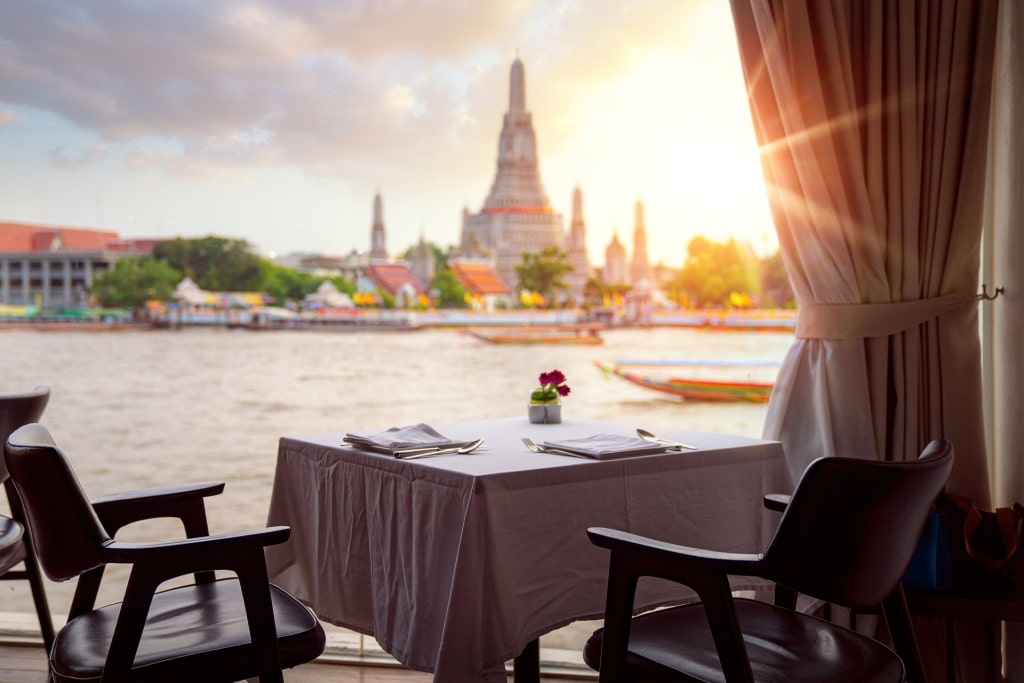
Sala Rattanakosin Eatery and Bar
While you can find superb pad thai on almost every street corner in Bangkok—touristy Khao San is its epicenter—you’re guaranteed a mouthwatering bowlful at the high-end Sala Rattanakosin Eatery and Bar. The magnificence of the pad thai will be matched only by the view across the Chao Praya, where the spectacular Wat Arun temple stands looking like a cross between an Egyptian pyramid and a Cape Canaveral shuttle launch.
Read: Best Street Food in Bangkok
1 p.m.: Visit Jim Thompson’s House
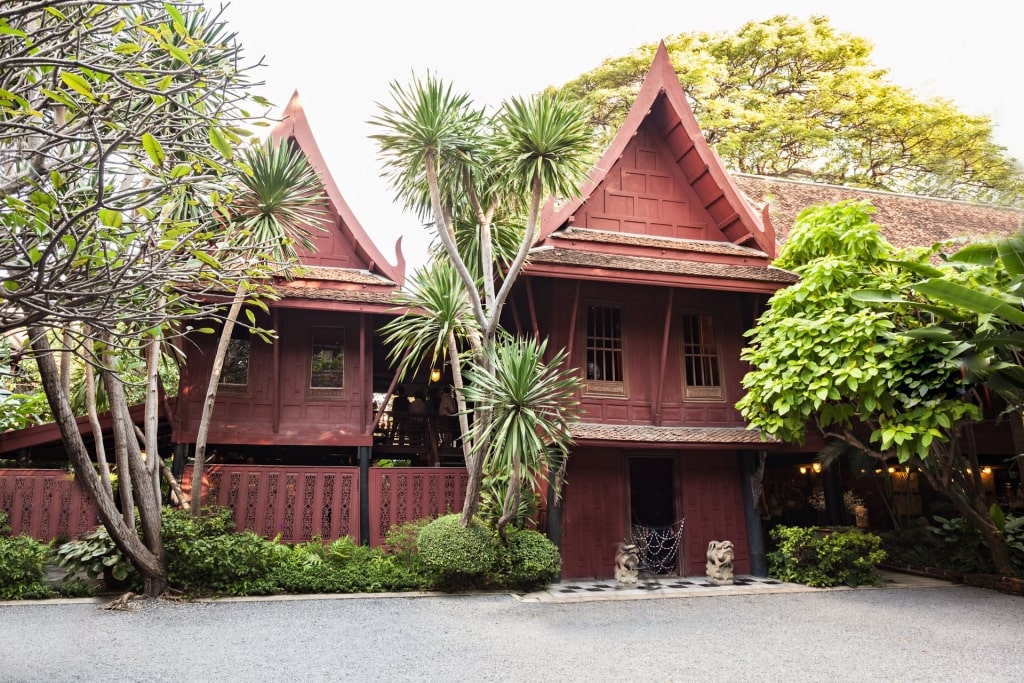
Jim Thompson’s House
Jim Thompson’s House is a prosaic name for a place that is, on several levels, remarkable.
The American businessman James Thompson—also known as “The Thai Silk King”—was famous in Southeast Asia for helping to resurrect the country’s silk industry to its former glories during the ’50s and ’60s. Besides this successful career, Thompson previously worked as an architect and a CIA officer. That he was to disappear mysteriously, never to be found, only burnished his already powerful mystique.
When he was eventually declared dead, his art and antiques collection were declared open to the world. The eponymous house—constructed from several repurposed Thai houses and straddling a canal—was designed by Thompson to showcase his collection. When inside, you’re admiring the architecture as much as the art—which, at the time of its collection, was deemed the finest assemblage of Southeast Asian art anywhere in the world.
3 p.m.: Explore the Temple of the Golden Buddha
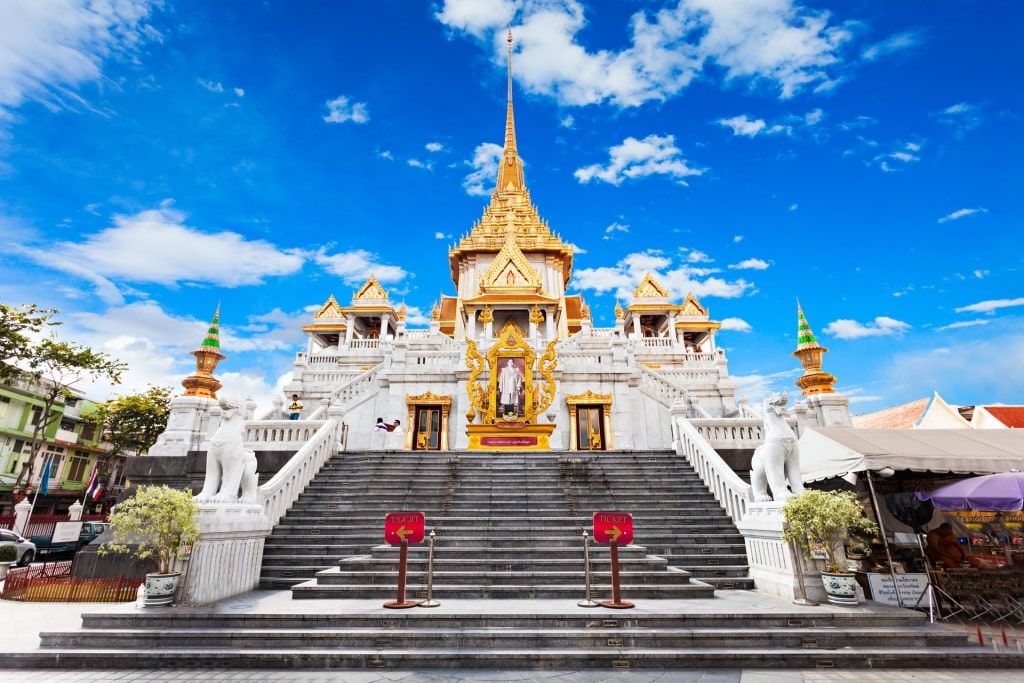
Wat Traimit
Undoubtedly a piece that Jim Thompson would have happily added a large extension to his house for, the Golden Buddha is another must-see Thai cultural artifact.
Nearly ten feet tall and weighing over five tons, the Golden Buddha is housed within the white and gold grandeur of the Wat Traimit Temple. Besides its overwhelming size and the fact that it’s forged from solid gold, the statue also carries with it an interesting history.
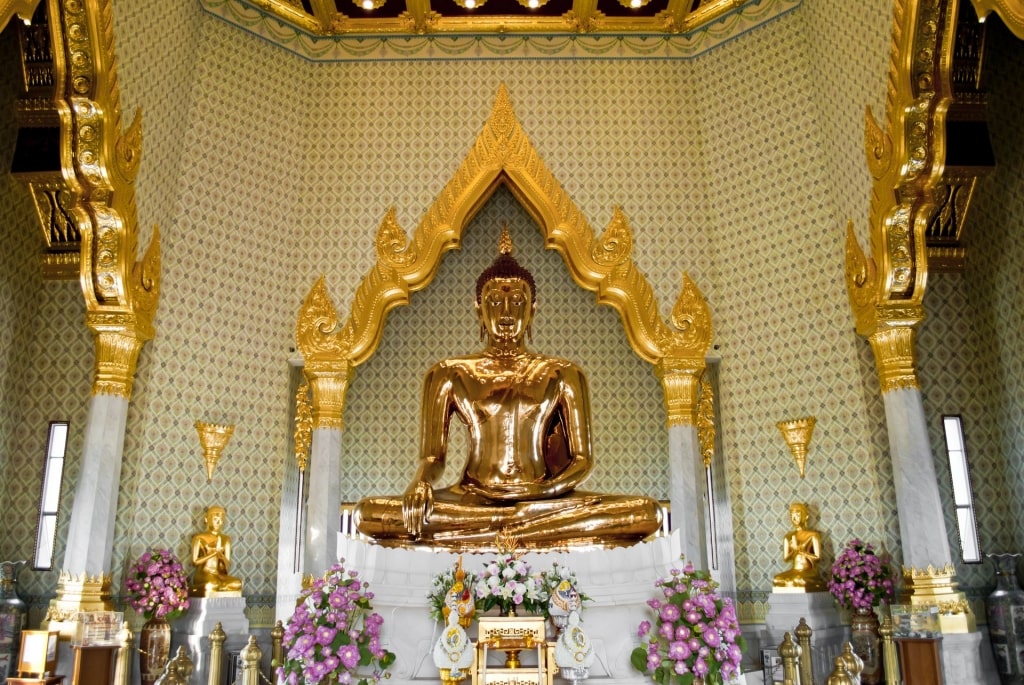
Golden Buddha, Wat Traimit
It’s believed that in the late 18th century, the Golden Buddha was disguised in plaster and colored glass to hide its material worth from marauding Burmese invaders. The statue remained like that for two centuries, until it was dropped from a crane mid-transit and cracked open. Upon revealing the statue in its entirety, it was found that the Golden Buddha was composed of nine parts that can be disassembled for transportation (one imagines that they probably wished they’d dropped it earlier in the journey).
Its re-discovery coincided with the commencement of the 25th Buddhist Era, ensuring that the finding of the Golden Buddha was regarded as a 24-carat miracle. Once you’ve marveled at the solid gold statue, you can learn more about its fascinating history and construction at the museum located on Wat Traimit’s third floor.
7 p.m.: Cruise the Chao Phraya
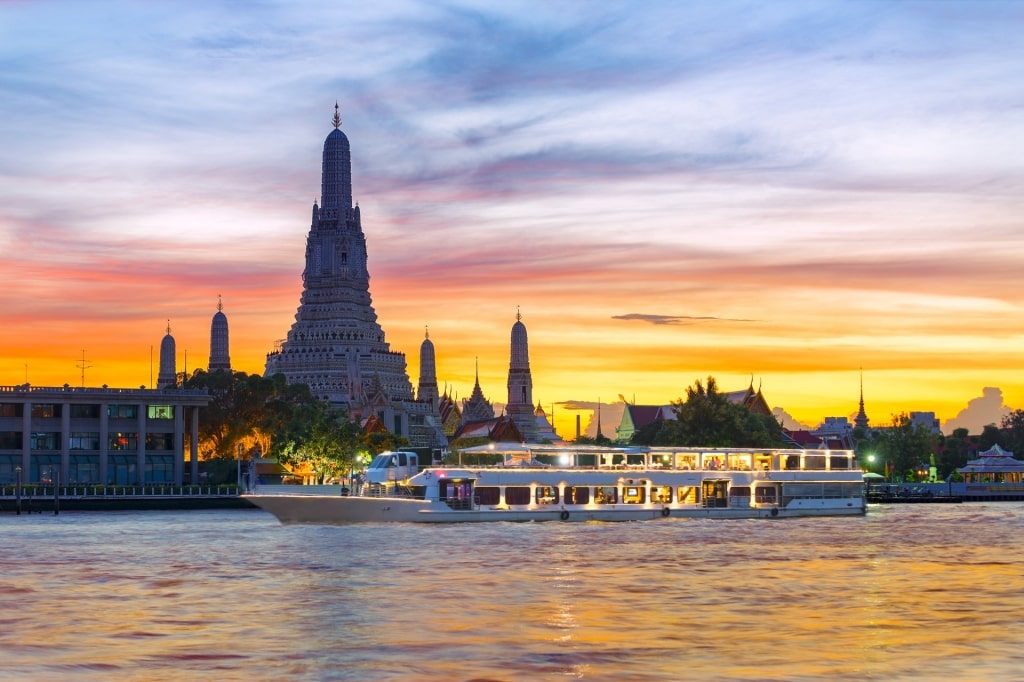
Chao Phraya river cruise
By the mid-point of your two days in Bangkok, you’ll have no doubt seen the stately Chao Praya wending its way past the temples and city skyscrapers.
The major waterway around which the city was built, the Chao Praya’s reddish-brown waters are contributed by the northern rivers that merge before passing through Bangkok and spilling their nutrient-rich cargo into the Gulf of Thailand. While journeying through the city, the river is a haven for waterside markets, needle-nosed water taxis, and those seeking a brief escape from Bangkok’s diurnal fervor.
A river cruise is one of the most sophisticated ways to step out of Bangkok’s fast lane while still enjoying the city around you. While the sunset tints the sky fuchsia, step off the hot tarmac of the cracked city streets and onto the gently rocking restaurant boat. During your three-course meal, luxuriate in the breeze off of the water while reviewing the highlights of your day, the sharp silhouettes of the temples fading into the gloom.
Day 2
9 a.m.: Shop at Chatuchak Weekend Market
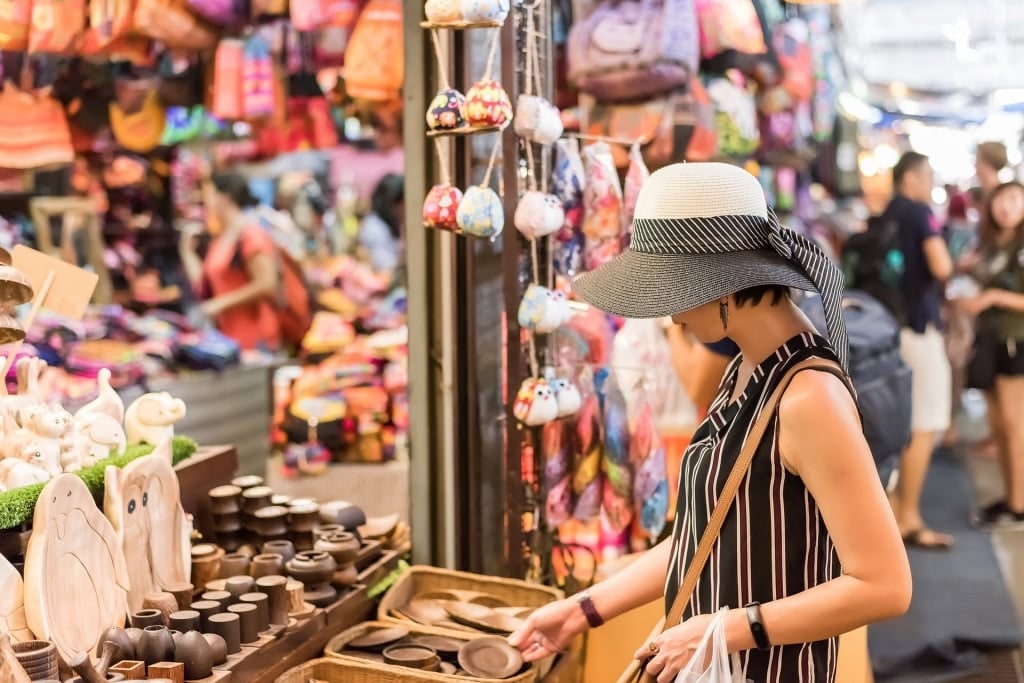
Chatuchak Weekend Market
Brush off your bartering skills to score some of the best Thailand souvenirs—Asia’s largest street market is an epic cultural and commercial experience. Covering 8,000 stalls spread across 35-acres, you’ll find more than a few bargains, a number of genuine surprises, and insight into Thai and Southeast Asian culture.
Knitted handbags, baby alligators, antiques both genuine and forged—Chatuchak is one of Bangkok’s best markets, an electrifying melange of the banal and the exotic. While it might, upon arrival, appear well organized—the numbered aisles, the encircling walkway—the categorizing of products can often prove baffling. Just make sure you’re not in a rush anywhere, barter with a smile, and soak it up.
Chatuchak runs Fridays as well as on Saturdays and Sundays. This commercial labyrinth is a popular excursion for locals as well as tourists, so early arrival is highly recommended.
12 p.m.: Explore Off-the-Beaten-Track Ari
A short Skytrain hop from Chatuchak, Ari is an up-and-coming neighborhood where traditional shops like cobblers and tea shops rub shoulders with minimalist spas and quirky fashion boutiques. Besides being now firmly on the radar, its ambiance feels organic and relaxed, distant from the tourist whirl of the central sights.
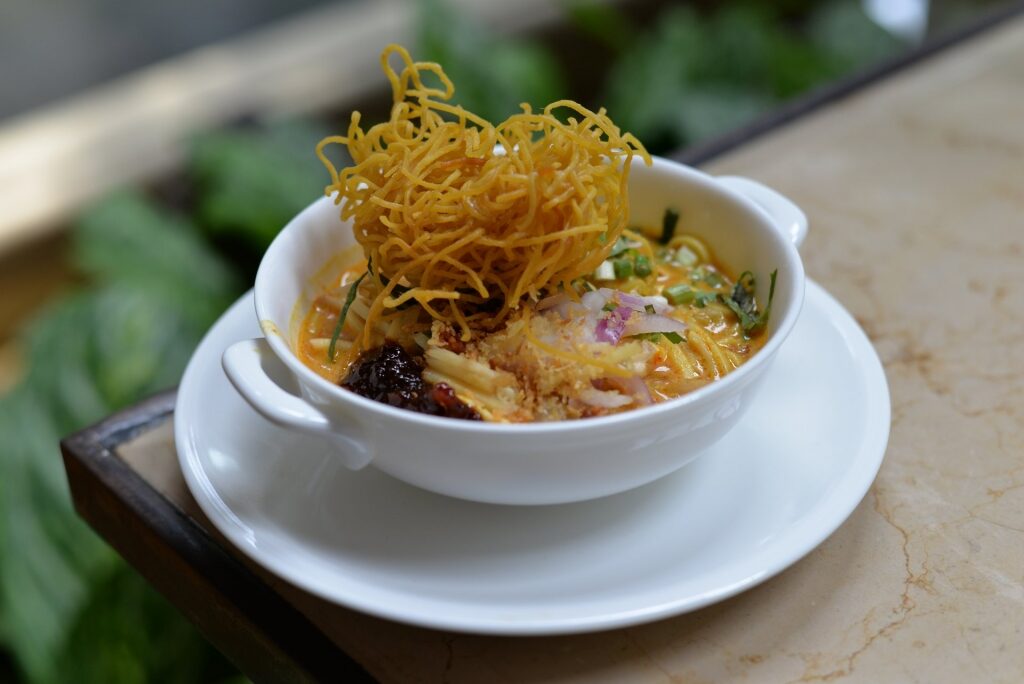
Khao soi
One thing that it does share with the rest of the city is a flair for food. Begin on its main artery, Phanon Yothin 7, and browse the street stalls huddled in the lanes or the elegant window dressing of the brick-and-mortar cafes. Try unique menu options, such as pad pongali gai—vibrant chicken curry with celery leaves and mushrooms marinated in a spicy yellow sauce—or the northern specialty, khao soi (best eaten at dedicated Ari-based Khao Soi restaurant, Ong Tong Khao Soi).
Visit at night, and Ari’s food scene comes alive. Its night market is extensive, well lit, and the evening air mouth-wateringly fragrant. While the most difficult part of having only two days in Bangkok might be what to do with your single night in this city renowned for its nightlife, you’ll find Ari won’t disappoint.
1 p.m.: Travel back in time at the Ancient City
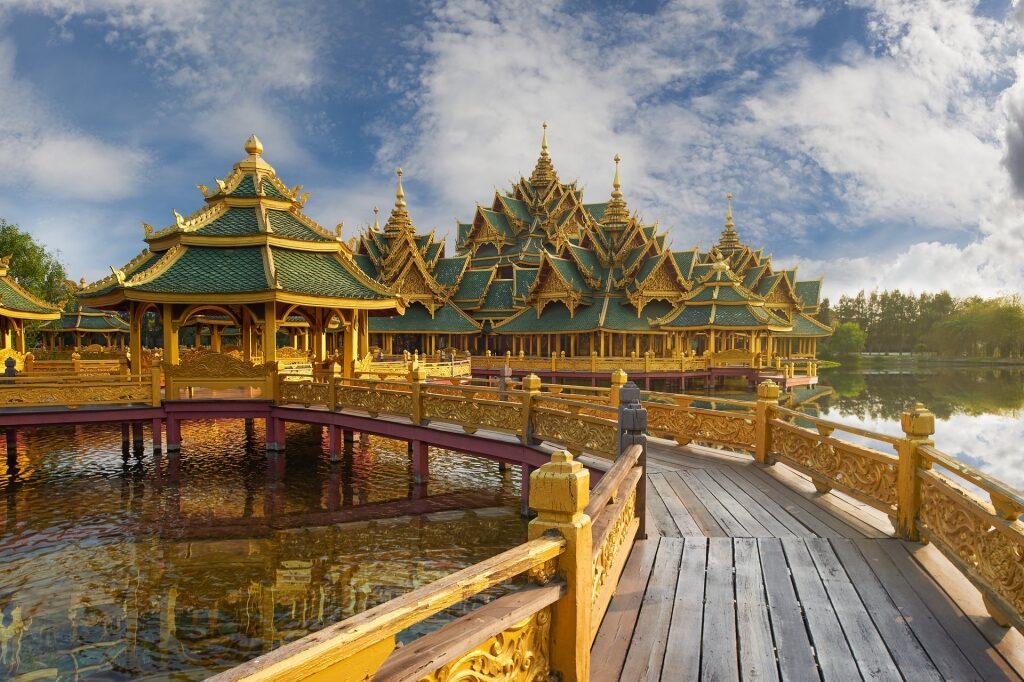
Ancient City
About an hour’s drive south of Bangkok is the Ancient City, a sprawling outdoor museum that showcases the country’s grand cultural heritage. The museum is also known as Ancient Siam—the country’s name prior to the advent of democracy and its shift to a constitutional monarchy.
Handsomely presented across 300 acres shaped to mimic the country’s geographical outline, the Ancient City offers scaled-down replicas of the significant cultural sites that Thailand is known for. If you’re thinking that sounds like an incredible mini-golf concept, you’d be close to the origins of this unique park.
The Thai millionaire who created Ancient Siam had originally intended the land for a mini-golf course. However, his growing awareness of the often dilapidated condition of the country’s cultural sites spurred him to create a kind of cultural insurance policy for the edification of future generations.
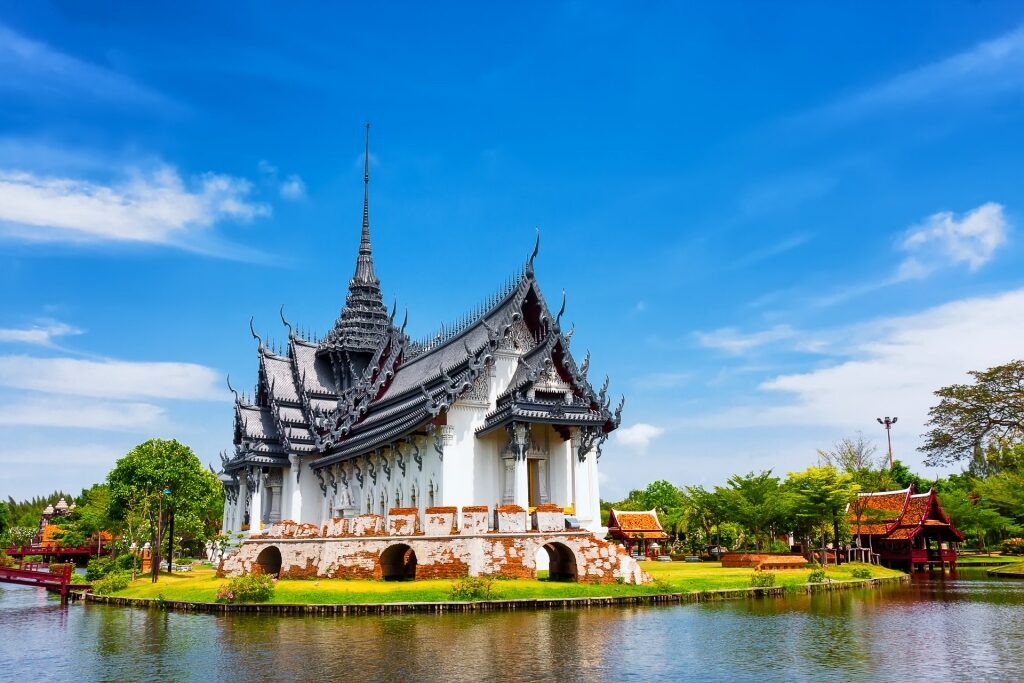
Sanphet Prasat Palace, Ancient City
It’s also edifying for tourists with only two days in Bangkok who are forced to make hard choices regarding key sites. In Ancient City, you can make amends—and without the crowds. Hire bicycles or hop on the tram service and freewheel through an enjoyable afternoon of cultural and architectural appreciation.
While the majority of buildings are reconstructions of existing sites, some are models of buildings that have disappeared, while a few are the originals—dismantled, transported, and re-built for the park.
3 p.m.: Venture to Damnoen Saduak Floating Market
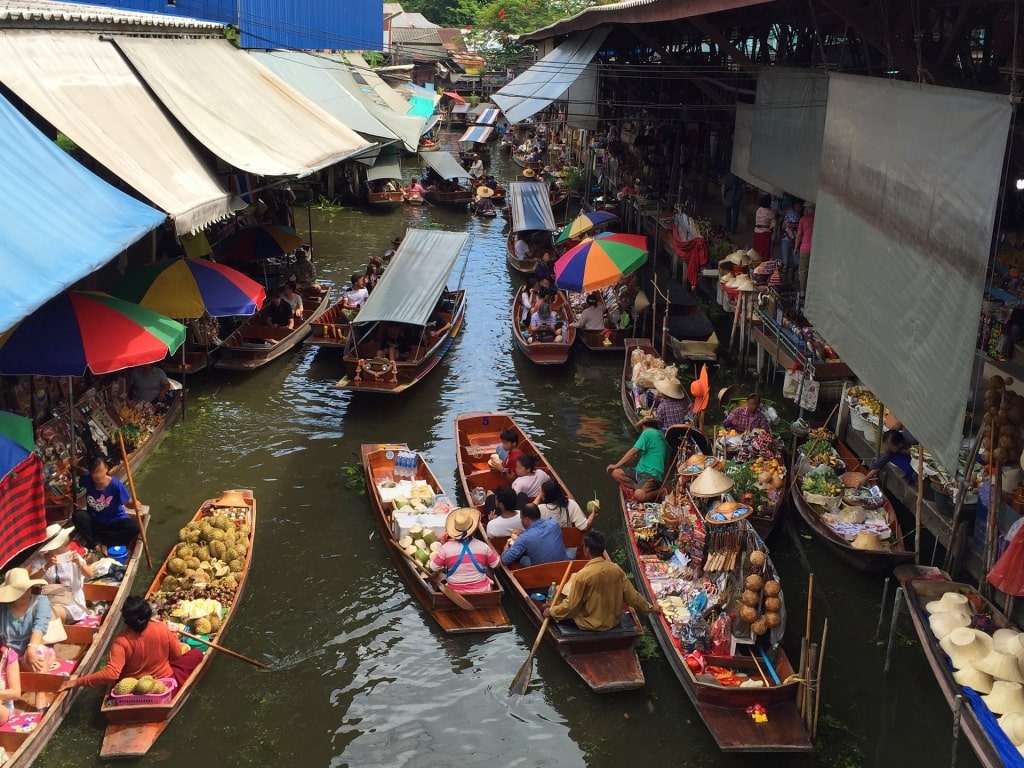
Damnoen Saduak Floating Market
If you’ve time on a two-day Bangkok itinerary, spend an afternoon at the Damnoen Saduak Floating Market. It is a one-hour drive southwest of the city, so it’s a significant time commitment—but one that comes with solid rewards.
This vibrant stretch of canal teems with commerce, steaming bowlfuls of meaty boat noodles, and piles of fresh and tangy dragon fruit. Created in the latter half of the 19th century, the Damnoen Saduak Canal was an engineering initiative to join up the Mae Klong and Tha Chin rivers. Villagers, now with the chance to sell their wares further afield, created a community of floating markets along the canal. With the advent of local road infrastructure, the floating markets began to close.
It’s a special remnant of Thai history, even if today’s iteration of the market is preserved in the amber of tourism. If you fancy thrusting yourself into the center of the action, it’s also possible to hire a long-tailed boat and barter on the water for that bowl of coconut ice cream.
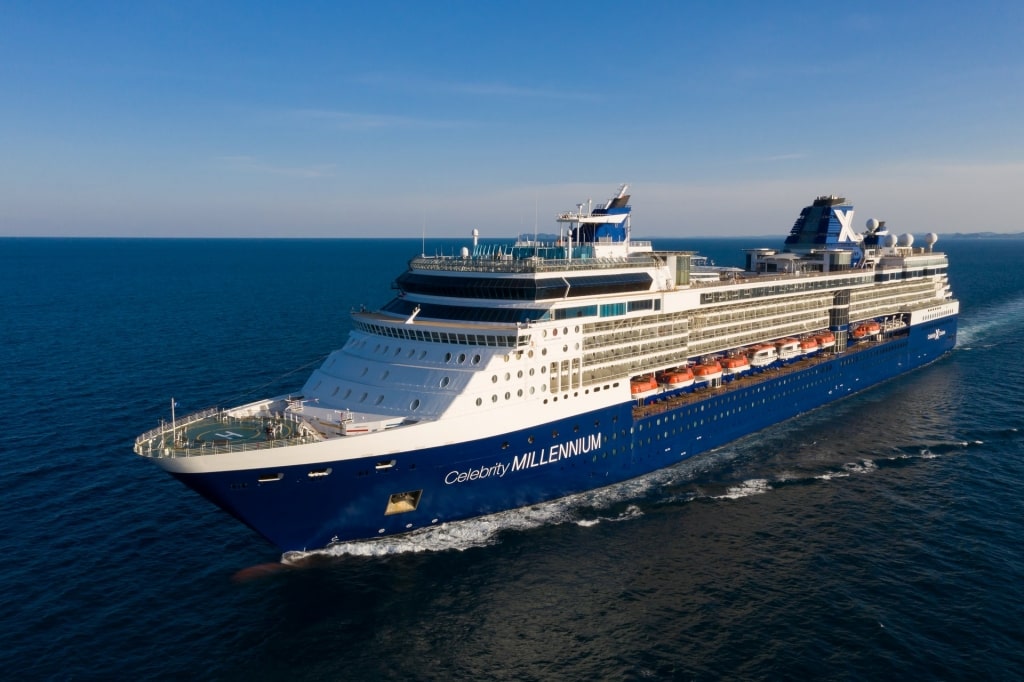
Celebrity Millennium
Discover the vibrant city of Bangkok and other fascinating destinations in the region on a Southeast Asia cruise. Experience the rich culture, delicious cuisine, and spirited atmosphere of the city, then indulge in luxurious accommodations, world-class restaurants, and thrilling entertainment onboard.
Browse cruises to Thailand on our website and book a cruise vacation to see the captivating wonders of Asia.
